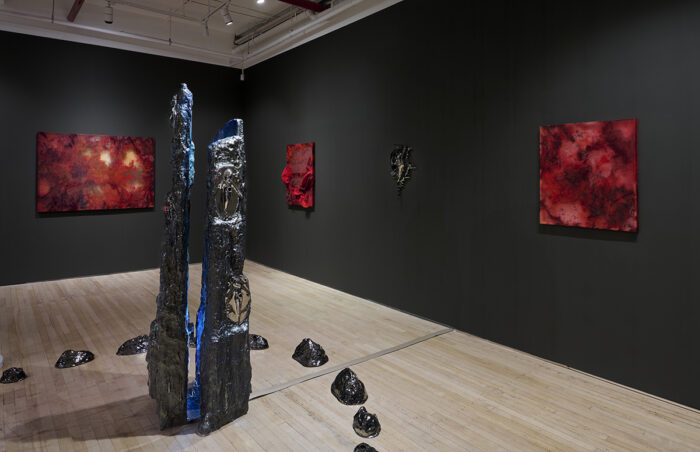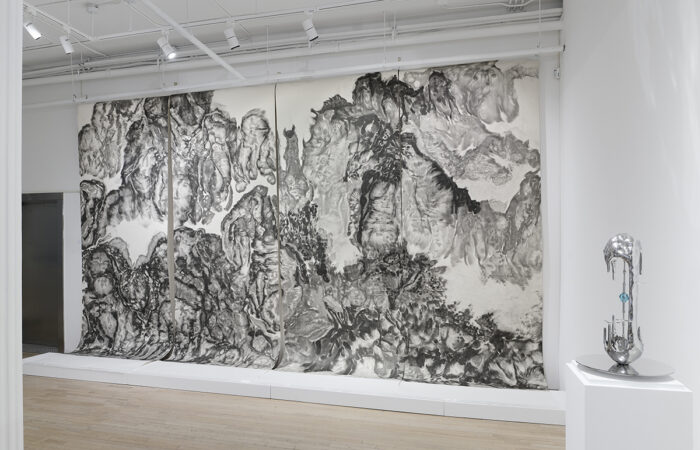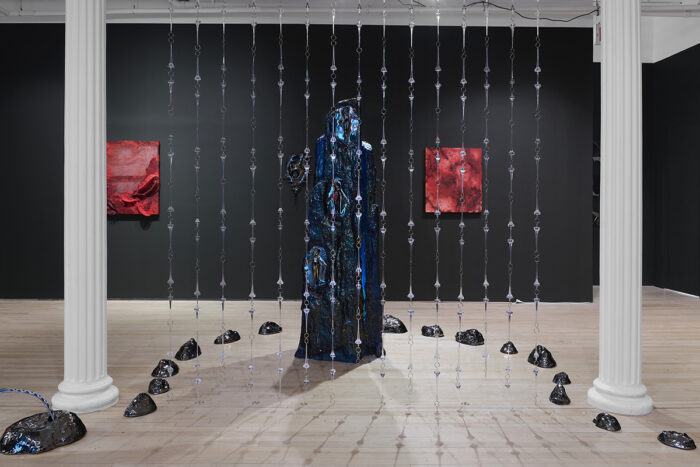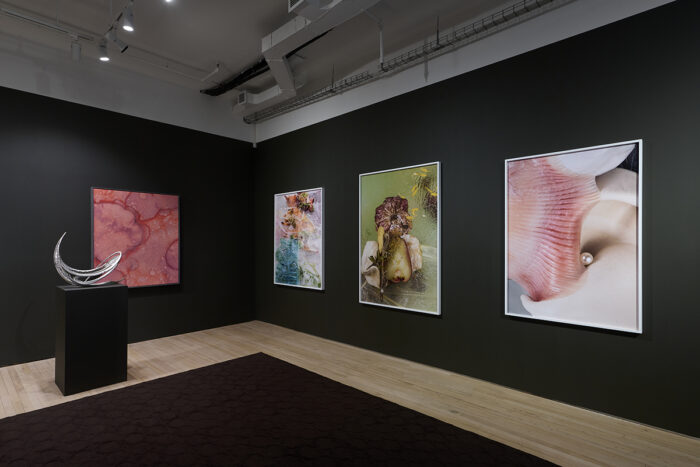
Can we draw a Trinity with Poetry, Art, and Philosophy, with art right in the middle bridging the other two?” Curator gaoyuan wrote on the back of a bar receipt, which she later published in the book 3 A.M. Provocations: In Lieu of a Curatorial Statement for the exhibition she curated, Theater of Energies, at Arsenal Contemporary, New York.
Since we met in a Beijing siheyuan years ago, I have always listened to her evolving idea about curating an exhibition in a poetic manner, echoing what Heidegger said that art is poetry. Our equally tumultuous life made us reconvene again and again in North America — “parachute kids”—that we’ve come to be called — meaning kids who, supported by their families, have been abruptly tossed onto foreign lands — a life trajectory that could be exemplary of postmodernity, characterized by an ever-enhancing sense of Heideggerian undwelling. Yet this undwelling is distinctive not only of individual lives but also of a condition of life, an epoch in which everyone struggles to familiarize the unfamiliar and vice versa in each of our different and resembling ways, geographical, temporal, corporeal, psychological, and beyond. If “parachute kids” is but a metaphor for the flâneur-like alienation towards a fabricated picture of heimatland, and alludes to every continent’s history having been rewritten by waves of movements and displacements of all kinds — no more categorization of “culture,” then, no more identity, and no more politics — art never grovels to politics, for art exists prior to society and is primordial — this is what Heidegger meant by the origin of work of art, and it is such artistic core before the construction of society that Theater of Energies is searching for. This conceptual framework is not only the result of the nine-months-long theoretical research when the exhibition was conceived but also the drifting space for the mind behind the creation of Theater of Energies, an exhibition that, to me, is itself a work of art that is simultaneously an assemblage of artworks, a strategy of display that choreographs a space of philosophy in Jean-François Lyotard’s legacy.

Art begins at the end of philosophy —says Bingyi, the creator of Can the Eyes Sing? Bodies of the Sacred Mountains, a work of a mountainous scene staged as a monumental waterfall in the prestigious artistic medium of the Song Chinese literati — ink and ink alone. Sewing with ink, weaving across the infinite space between light and dark — I can hear the painting’s breath, starting with a howling imbued with angst, a howling that is gradually replaced by the crisp dripping sound of water streams. This cycle of impassioned turbulence and composed serenity reverberates with the sound of Julian Zehnder’s Beyond Dissolving Limits. Yet the two works reverberate in dissonance: in the fountain, the color black becomes shiny, artificial, estranging since the access toward god-given nature is provided precisely by the aid of man-made technology, and it is impossible to separate the pure from the impure, for purity is an illusion as Zehnder says. The two works co-orchestrate a provocation toward the ambiguous relation between our senses and the surrounding environment, ecological and historical. From now on the way we see things should be different. The hyper-stimulated senses of ours coming from outside the exhibition space are washed over by a powerful black and white monochromy, the monochromy that, in my view, is the ultimate color of this world.

Theatre of Energies can be anything but a white-box exhibition. Going past Motohiro Takeda’s site-specific ensemble with the work Trinity, where flowers grow in a waterfall of burned charcoal and ashes, we come to the next climax in this space of intercoursing energies heralded by Nicolas Lachance’s Triade — there must be some historical residue and cognitive inclination for us to model our world into systems of threes — the father, the son, the holy spirit; poetry, art, philosophy; streams, obsessions, continuums. This motif is also evident in Kevin Heisner’s phygital séance staged as a three by three altar and Leah Ying Lin’s site-specific installation with a three-part monolith in the next room. At the center of Act II titled Obsessions are Lin’s set of glazed ceramic in the shape of a sacred mountain at a site of futuristic ruins. Mountain and water, shanshui, is the god of Chinese people, as Bingyi used to say. If that is so, is the gallery space here turned into a miniature altar? But as the mountain emits blue light in an extraterrestrial manner, the visitor of this scene, either possessing familiarity according to the culturally coded visual vocabulary, or an opposite attitude, being without acquaintance with the shape of the installation’s reference, feels estranged from the scenery both disclosed and undisclosed via the mediation of a crystal veil, framed by two columns evoking the visual language of the Hellenistic antiquity. Which one is more familiar, the Shanshui or the Classical columns?

Instead of provoking the question of a rather apparent sense of combination and hybridity, two convenient terms that, in my view, could only reinforce the boundaries between cultures narrowly and essentialistically defined, should we rather ponder upon a symbiotic relationship between the artist and the gallery — the site to this site-specific work in this case — within the contemporary industry from where art seems to originate from, in a manner distinct yet also resembling the mechanism observed by the phenomenologists? The artificial veil, in this case, embodied by resins processed by the artist’s hand, reveals and conceals the ceramic mountain and other paintings in the gallery at the same time; the subject of disclosure and coverage varies depending on the side one takes when viewing. Standing beside the installation, one sees Michelle Bui’s set of photography works in a different way: drizzles of flickering glitters scatter over the flimsy, fragile fibers and skin, transparent but not seen-through. Amy Hui Li’s powerful, volcanic scarlet pigments, on the other hand, seem to encroach on the veil of such a simulated waterfall, and it is impossible to see the work as something still. The inflaming, burgeoning, self-reproducing color whose corporeality is underscored by the organic shape and texture makes me, perhaps anachronistically, think of blood in J. W. M. Turner’s Slave Ship, for there is a congruous visual language in the two works that I come to cement, consciously or not, into the habit of my seeing, a motif for violence physical, historical, and psychological all at once. In every finite individual, there shields an infinitude of turmoil; in a single work of art there is an allusion to cosmology and history past and present — my thinking coincides with the poetry of William Blake as I write, my mind drifts in the space of art and philosophy materialized by the word. At last, I find, being in this theater of energy, it is precisely when we unfamiliarize the familiar that we find the authentic, from which art originates.



